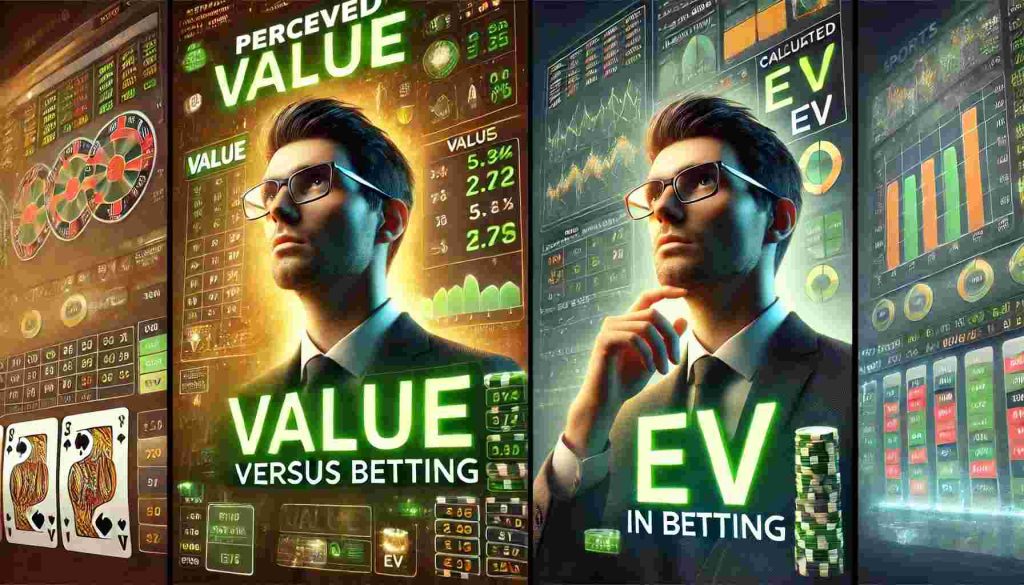In this article, we will explore the concept of value and expected value (commonly referred to as “EV”) and how to Calculate Expected Value.

We frequently hear that value is synonymous with underdogs, but there is minimal correlation.
Value isn’t exclusive to underdogs. Depending on your approach, you might be equally likely to discover value with favorites.
It’s important to mention that Value can additionally “double up” alongside Closing Line Value.
Is Value (or Expected Value / EV) a term that relates to a bet you made, compared to where the line closed?
This is akin to Closing Line Value; however, we will delve into the reasons it’s referred to as value and explore how it can be leveraged for an advantage.
It’s important to highlight that when comparing these wagers, we use the ‘No-Vig Line.’
We should always keep in mind that every line, like -2 or -2.5, includes the juice of -110 attached to it, commonly referred to as the vig or vigorish.
In this case, with both sides at -110, the vig amounts to 4.55%. Overcoming this is crucial if you aim for long-term success.
While you bet on -2(-110), it’s crucial to remove the vig from the closing line, adjusting it to be -2.5(+100).
The shift from -2 (-110) to -2.5 (+100) remains a negative value change of 1.50%, even though there’s a 0.5 point adjustment in your favor.
This is an important difference!
Now, if you bet on -2 (-110) and the line closed at -3 (-110), removing the vig from the -3 shows that you’ve achieved a +1.78% positive value!
If you’re curious about how we arrived at the +1.78% value, it’s a bit complex; however, a quick online search for Closing Line Value Calculator, CLV Calculator, or Value Calculator should give you plenty of resources to explore.
By having a solid grasp of value, you can identify and capitalize on outdated figures in the market.
For instance, if you observe that prominent market-making sportsbooks like Circa, Pinnacle, and Bookmaker have shifted their NBA lines from -2 to -3, but FanDuel has not yet adjusted and is still offering the line at -2; you can seize the opportunity by betting on FanDuel’s -2 to gain a +1.78% expected value!
Does +1.78% value indicate that you can anticipate earning $1.78 for every $100 wagered?
As a professional sports bettor, it’s crucial to focus on value since this approach provides a realistic expectation of your long-term profit potential for any wager.
This is based on both the edge you have and where the line ultimately closes.
To elaborate on this point, let’s assume the initial bet of -2 (-110) closed at -4. Once the vig is removed from the closing line, you gain positive value around +9%.
This implies that for each $100 you bet, you can anticipate a profit of $9.
This is how value functions and can be applied to any price range.
For instance, in moneyline sports betting: if you place a bet at -200 and the odds close at -250, it remains a positive expected value (+EV) wager that will yield long-term profits.
Value doesn’t equate to favoring the underdog. For instance, there’s no value in betting on an NBA team at +10 if the true line is +12. But if the correct line should be +7, then we’re looking at a valuable opportunity worth considering.
Don’t be misled by the popular belief that you need to bet on underdogs to uncover value.
Professional sports bettors will wager on a -500 line if they believe the odds for that team should be set at -700.
Engaging in price discrimination can negatively impact your long-term success.
Grasping the concept of value and its function in the marketplace is essential for becoming a professional sports bettor.
Here are some mental strategies to consider when placing a wager, ensuring you keep and Calculate Expected Value in focus.

